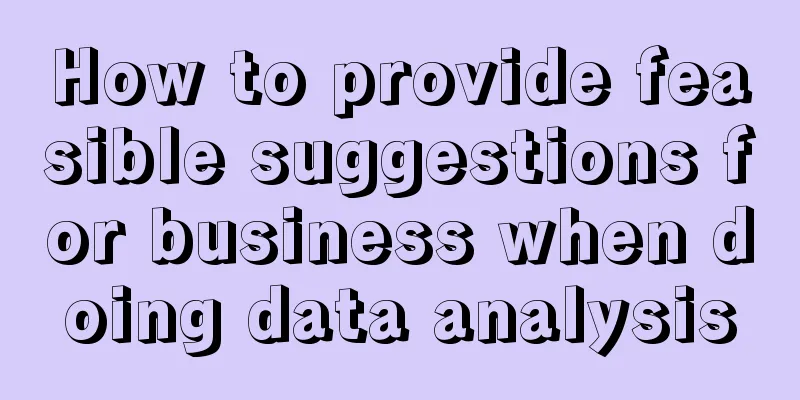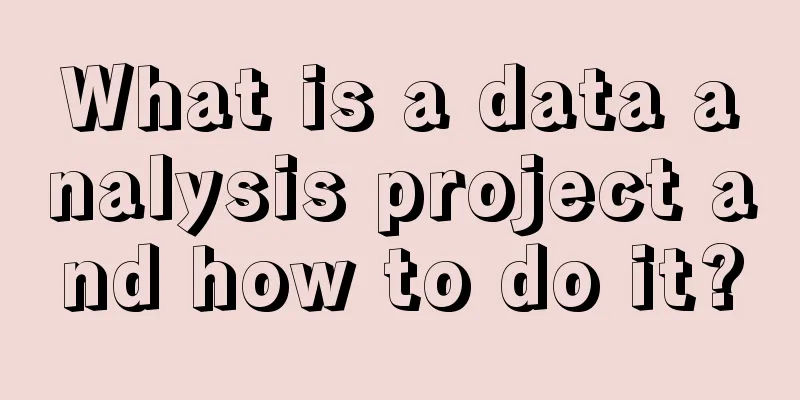How to provide feasible suggestions for business when doing data analysis

Many students hate being a tool, but every time they are asked to make suggestions, they are afraid to say anything except "the indicators have dropped, we need to raise them." Today, I will take a specific question and give you a detailed introduction: how to draw feasible suggestions from data. Problem scenario: The boss of a certain Internet vertical e-commerce company said: Product A has been selling well recently, and he wants to raise the price to increase the overall profit of this type of product. Now as a data analyst, you have received this request and asked: What should I do? 00Problem AnalysisFirst of all, students should pay attention: Are there a few questions here? Think about it for a minute. If the business department hears this kind of order, their instinctive reaction is: "Here is a problem. The boss wants to raise the price. How should I raise the price?" However, when a data analyst receives this kind of demand, he will not interpret it this way. Because the first thing a data analyst needs to ensure is that the leadership's decision is based on correct facts, and then to ensure the feasibility of the decision-making recommendations. For data analysts, there are two questions here: Question 1: Is what the boss said, “Sales have been good recently”, true? Question 2: Based on the premise that Question 1 is established, think about how to implement it 01The first step in solving the problem: confirm the factsIn reality, many business perceptions are not based on facts. Whether sales are really good at this moment needs further verification. Moreover, this task is best suited for data analysis. When a business department captures business opportunities, it may rely on its own experience, judgment, and sense of smell, but when data analysis captures business opportunities, it must rely on data. To verify question 1, the assumptions that need to be excluded are:
The entire logic is summarized as follows using the MECE method: Many novice data analysts will ignore this step. In fact, this step reflects the value of data analysts. The boss just said it casually, and the data analyst ruled out various possibilities one by one. It is a very good experience for the boss. It seems that the data analysis work is done very in-depth. In fact, there is a fixed pattern for when to increase prices, which is generally based on the product life cycle (as shown below):
On the contrary, if product A is in the late stage of its life cycle, has surplus inventory, and performs mediocrely, then price increases should not be considered. Instead, measures such as bundling and discounts can be considered. 02 Step 2 of problem solving: Distinguishing between experience and testingIf the first step is confirmed, you can do the second step: determine the analysis direction. The second step is to confirm one thing: Have similar price adjustments been made in the past? If so, analyze the expected impact and feasibility of this price adjustment based on the last similar price adjustment scenario. If not, there is no historical data reference, and you need to design a data experiment to verify the feasibility of the solution. This is a good example of the difference between data analysis and business thinking. If you change business, you may be able to make a direct judgment through communication with customers, insight into users, and understanding of products. But data analysis must start from data. If there is historical data, analyze based on historical data. If not, do a test first, collect data, and then analyze. Of course, the two can be combined in actual implementation. For example, the business first proposes a price increase plan, and the data analysis is divided into two steps: 1. Prior demonstration: This plan has no fatal flaws 2. Post-event demonstration: This solution can be verified through XX experiment This will push the plan forward. 03 The third step of problem solving: prior argumentationThere are two types of prior argumentation: 1. Summarize historical experience and give suggestions when price adjustments have been made 2. If there is no price adjustment, give the scope of price adjustment to avoid pitfalls. For a plan to be implemented, the six elements of time, place, people, cause, process, and result must be complete. Therefore, when reviewing historical experience, you must be more detailed and analyze the six elements of the last price adjustment in full (as shown in the figure below). exist When avoiding pitfalls, the main thing is to use data to eliminate some obviously unreasonable assumptions. In theory, consumers are not stupid. Price adjustments will lead to a decrease in sales; a decrease in sales will lead to an increase in inventory and a longer turnover time; a longer turnover time will increase the risk of product obsolescence, which may further affect sales. Although there is no data to prove it, the business side must consider these points when making plans. Typical unreasonable assumptions, such as: 1. The price increase is set too high, even reaching the price of higher-end products 2. Sales volume has not been adjusted, and the default price increase will not affect sales volume 3. Sales estimates are too high, without considering the increase in inventory due to decreased sales Most of these obvious bugs come from the overly optimistic assumptions of the business side without experience. As a data analyst, you should warn them of such optimistic assumptions, or at least make them aware of the problem. 04 Step 4 of problem solving: Post hoc argumentationIf there is no historical data accumulation, you need to design a data experiment to verify the effect. Note: The design of the data experiment must require the participation of the business side. Because price increase itself is a business action, there are two basic ways: open increase/hidden increase. Clear price increase: direct price adjustment Hidden price increase: secretly adjusting prices by launching upgraded versions, plus versions, reducing coupons, etc. These measures may produce different effects. If it is an open price increase, you can directly test the price sensitivity of all users. If it is a hidden price increase, it means that only a part of the users will respond to the price increase, so you need to group the users and observe the reactions of some users (as shown below): In theory, hidden price increases are easier for users to accept emotionally, after all, an obvious price increase seems to be too much of a rip-off, and it feels like hoarding. But in practice, hidden price increases require a new marketing plan, and it is very likely that the new plan will fail, resulting in the failure of the price increase strategy, and the business side will bear the responsibility. Therefore, the business side will tend to expect a clear increase and ask data analysts to make predictions: how much the price will increase to maximize ROI. Here, we must make it clear to the business side: without historical data, there is no analysis, and testing is necessary. Don’t try to avoid this question by guessing or other roundabout methods. Price elasticity must be tested. If you draw conclusions without testing, the risk of strategy failure is borne by the data analyst himself... 05 SummaryFrom the above, we can see that a simple price increase requires a lot of detailed analysis, specific to various scenarios. Many novices do not consider so many scenarios, but just take the sales volume of the past week or month, and then start to guess: "Maybe the price increase will reduce sales..." Working so roughly, it is easy for the leader to diss me in various ways, such as: “Have you considered the difference with other categories?” “Will it only be a short-term effect?” “Is there any evidence that prices can really be raised?” The data analyst will say aggrievedly: "You didn't mention that either." At this moment, the leader said again: "Why don't you think about it more!" After all this back and forth, trust is gone. We often say that data analysts are the military advisors of enterprises. In novels, when the lord asks the military advisor for advice, the military advisor has three strategies: the best, the middle and the worst. The best strategy can be divided into the best strategy, the best middle strategy, and the best and the worst strategies. The work is done very meticulously and the scenarios are thought through comprehensively. This is the standard that a qualified military advisor should achieve. The above is for everyone to encourage each other. |
<<: How to sell products on Xiaohongshu
Recommend
How to operate the ozon e-commerce platform? How to do it well?
With the development of the cross-border e-commerc...
Xiaomi's new copywriting is cosmic
Last year, Xiaomi launched a foldable screen mobil...
What is the difference between THC charges and terminal charges? What are the ocean freight surcharges?
When friends open a store on a cross-border e-comm...
Can the “lowest price” save e-commerce platforms?
This article introduces Kuaishou's preparation...
Amazon announces the latest delivery time for Black Friday and Christmas
Amazon's US and European sites have announced ...
8,000 words of useful information | Learn "Brand Launch Conference" from Steve Jobs and Lei Jun: 6 rules and 18 techniques!
The 2024 new energy vehicle launch is in full swin...
How does Shopee open a Polish site? How to operate a site?
Now more and more merchants are opening stores on ...
Why is the new Chinese-style marketing only popular but not explosive?
This article explores why the new Chinese-style ma...
iQiyi, Youku and Tencent Video’s 618 promotion, are Apple users out of the game?
This article delves into the embarrassing situatio...
Car company bosses compete to become Internet celebrities
Lei Jun alone is as good as ten 4A advertising com...
What is the process for entering Alibaba International Station? Attached notes
As the world's leading B2B cross-border e-comm...
Perfect Diary, which is not even used by primary school students, can we play it again?
Perfect Diary, which was very popular in the past ...
Will Amazon's store be closed immediately after being linked? Analysis of the reasons why Amazon closed the store
There are many rules on the Amazon platform that a...
I am still not optimistic about WeChat video e-commerce
This article elaborates on the reasons why the aut...
90% of brands are in the No. 1 position, but sales have not had a good life
This article proposes that we all know the importa...









